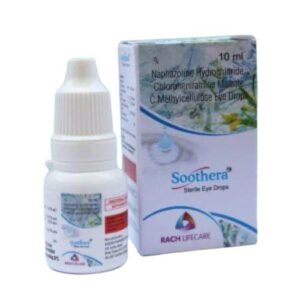CHLORPHENARAMINE MALEATE + METHYCELLULOSE + NAPHAZOLINE HYDROCHLORIDE
Chlorphenaramine Maleate: Chlorphenaramine Maleate is an antihistamine medication that is commonly used to relieve symptoms associated with allergies, such as sneezing, itching, watery eyes, and runny nose. It is also used to treat symptoms of the common cold, hay fever, and allergic reactions to insect bites or stings.
The drug works by blocking the action of histamine, a substance in the body that is responsible for causing allergy symptoms. By antagonizing the histamine receptors, Chlorphenaramine Maleate helps to reduce or prevent symptoms caused by the release of histamine.
Chlorphenaramine Maleate is available in tablet and liquid forms and is typically taken orally. The usual recommended dose for adults and children above 12 years old is 4mg every 4 to 6 hours, not exceeding a total daily dose of 24mg. For children between the ages of 6 to 12 years, the recommended dose is 2mg every 4 to 6 hours with a maximum daily dose of 12mg.
While Chlorphenaramine Maleate is generally safe and well-tolerated, it may cause some side effects. Common side effects include drowsiness, dizziness, dry mouth, blurred vision, constipation, or difficulty urinating. These side effects are generally mild, but it is important to avoid activities that require alertness until you know how the medication affects you. In some cases, rare but more serious side effects such as rapid heartbeat, confusion, or difficulty breathing may occur. If any of these side effects occur, it is important to seek medical attention immediately.
It is worth noting that Chlorphenaramine Maleate may interact with other medications, including sedatives, tranquilizers, and other antihistamines. It is important to inform your healthcare provider about all the medications you are taking to avoid any potential interactions.
Overall, Chlorphenaramine Maleate is an effective antihistamine commonly used to relieve allergy symptoms and can provide relief from various allergic reactions. However, it is essential to follow the recommended dosing instructions and be aware of the potential side effects associated with this medication. Always consult your healthcare provider before starting or changing any medication regimen.
Methycellulose: Methylcellulose is a medication that belongs to a class of drugs called bulk-forming laxatives. It is commonly used to treat constipation and to promote regular bowel movements.
The mechanism of action of methylcellulose involves adding bulk to the stool, which helps to stimulate bowel movements. It absorbs water in the intestines, forming a gel-like substance that increases the size and moisture content of the stool. This softens the stool and makes it easier to pass, relieving constipation.
Methylcellulose is available in a powder form, which is typically mixed with water or another liquid before consuming. The dose of methylcellulose may vary depending on the individual and the severity of constipation. It is usually recommended to start with a lower dose and gradually increase it until a desired effect is achieved. It is important to follow the instructions provided by a healthcare professional or the medication’s label.
Common side effects of methylcellulose include bloating, gas, and stomach cramps. These side effects are generally mild and temporary. In rare cases, severe allergic reactions may occur, which require immediate medical attention. It is important to consult a healthcare professional if any unusual or severe side effects are experienced.
Methylcellulose is generally considered safe for most individuals. However, it is important to inform a healthcare professional of any existing medical conditions, allergies, or medications being taken, as they may interact with methylcellulose. It is also advisable to drink plenty of fluids while taking methylcellulose to prevent dehydration.
Naphazoline Hydrochloride: Naphazoline Hydrochloride is a decongestant drug used to relieve nasal congestion caused by colds, allergies, or sinusitis. It belongs to the class of drugs known as alpha-adrenergic agonists.
The mechanism of action of Naphazoline Hydrochloride involves constriction of blood vessels in the nasal passages, which results in reduced swelling and congestion. This leads to improved breathing and relief from nasal symptoms.
Naphazoline Hydrochloride is typically available as a nasal spray and should be used as directed by a healthcare professional or as instructed on the packaging. The usual recommended dose for adults and children over 12 years of age is 2-3 sprays in each nostril every 10-12 hours, not exceeding 4 doses in 24 hours. It is important to avoid prolonged use of the medication to prevent rebound congestion or dependence.
While Naphazoline Hydrochloride is generally safe for use, it may cause some side effects. Common side effects may include temporary burning, stinging, or sneezing after administering the nasal spray. Other possible side effects may include headache, dizziness, increased blood pressure, nervousness, or difficulty sleeping. In rare cases, Naphazoline Hydrochloride may cause allergic reactions leading to rash, itching, swelling, or difficulty breathing. If any severe or persistent side effects occur, it is important to seek medical attention immediately.
As with any medication, it is important to discuss the appropriate use, dose, and potential side effects of Naphazoline Hydrochloride with a healthcare professional before starting the treatment.

